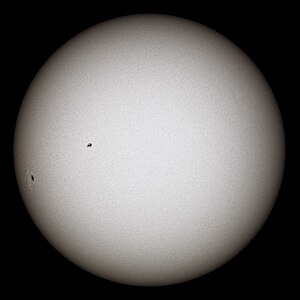Gotûbêj:Roj (stêrk)
Şiroveya dawî: Doh di 21:01 de ji aliyê Balyozxane ve di mijara Zêdekirina Agahîdankê de
| Ev rûpela gotûbêjê ji bo nîqaşên li ser pêşvexistina Roj (stêrk) e. Ev ne forumek e ku li ser mijara gotarê nîqaşên gelemper li dar bixin. |
Polîtîkayên gotaran
|
| Çavkaniyê lê bigere: Google (kitêb · nûçe · zanyarî · wêneyên azad · WP çavk) · JSTOR · NYT · Kitêbxaneya WPyê |
| Ev |
Zêdekirina Agahîdankê
biguhêre The Sun, viewed through a clear solar filter | |
| Names | Sun, Sol,[1] Sól, Helios[2] |
|---|---|
| Adjectives | Solar[3] |
| Symbol | |
| Observation data | |
| Mean distance from Earth | 1 AU 149,600,000 km 8 min 19 s, light speed[4] |
| −26.74 (V)[5] | |
| 4.83[5] | |
| G2V[6] | |
| Metallicity | Z = 0.0122[7] |
| Angular size | 0.527–0.545°[8] |
| Orbital characteristics | |
Mean distance from Milky Way core | 24,000 to 28,000 light-years[9] |
| Galactic period | 225–250 million years |
| Velocity |
|
| Obliquity |
|
Right ascension North pole | 286.13° (286° 7′ 48″)[5] |
Declination of North pole | +63.87° (63° 52′ 12"N)[5] |
Sidereal rotation period |
|
Equatorial rotation velocity | 1.997 km/s[11] |
| Physical characteristics | |
Equatorial radius | 6.957×108 m[12] 109 × Earth radii[11] |
| Flattening | 0.00005[5] |
| Surface area | 6.09×1012 km2 12,000 × Earth[11] |
| Volume |
|
| Mass | |
| Average density | 1.408 g/cm3 0.255 × Earth[5][11] |
| Age | 4.6 billion years[13][14] |
Equatorial surface gravity | 274 m/s2[5] 27,9 g0[11] |
| ≈0.070[5] | |
Surface escape velocity | 617.7 km/s 55 × Earth[11] |
| Temperature |
|
| Luminosity | |
| Color (B-V) | 0.656[15] |
| Mean radiance | 2.009×107 W·m−2·sr−1 |
Photosphere composition by mass | |
@Balyozxane bira merheba ji kerema tu dikarî di demekê guncaw de Agahîdank a ji ser Wîkîpediya îngilîzî li gotarê zide bikî. Penaber49 (gotûbêj) 18:51, 7 kanûna paşîn 2025 (UTC)
- Silav bira @Penaber49 rasterast şablonê kopî bike û çi dibînî bike kurdî jî xeynî parametreyên wekî label û data. Ji ber ku şabloneke xusûsî li ser ên.wikiye jî ne hatiye bikaranîn.----Balyozxane (gotûbêj). 21:01, 7 kanûna paşîn 2025 (UTC)
- ^ Xeletiya çavkanî: Invalid
<ref>tag; no text was provided for refs namedOED - ^ Xeletiya çavkanî: Invalid
<ref>tag; no text was provided for refs namedLexico - ^ Xeletiya çavkanî: Invalid
<ref>tag; no text was provided for refs namedOED2 - ^ Pitjeva, E. V.; Standish, E. M. (2009). "Proposals for the masses of the three largest asteroids, the Moon–Earth mass ratio and the Astronomical Unit". Celestial Mechanics and Dynamical Astronomy. 103 (4): 365–372. Bibcode:2009CeMDA.103..365P. doi:10.1007/s10569-009-9203-8. ISSN 1572-9478. S2CID 121374703. Ji orîjînalê di 9 tîrmeh 2019 de hat arşîvkirin. Roja gihiştinê 13 tîrmeh 2019.
- ^ a b c d e f g h i j k l m n Williams, D. R. (1 tîrmeh 2013). "Sun Fact Sheet". NASA Goddard Space Flight Center. Ji orîjînalê di 15 tîrmeh 2010 de hat arşîvkirin. Roja gihiştinê 12 tebax 2013.
- ^ Zombeck, Martin V. (1990). Handbook of Space Astronomy and Astrophysics 2nd edition. Cambridge University Press. Ji orîjînalê di 3 sibat 2021 de hat arşîvkirin. Roja gihiştinê 13 kanûna paşîn 2016.
- ^ Asplund, M.; Grevesse, N.; Sauval, A. J. (2006). "The new solar abundances – Part I: the observations". Communications in Asteroseismology. 147: 76–79. Bibcode:2006CoAst.147...76A. doi:10.1553/cia147s76. ISSN 1021-2043. S2CID 123824232.
- ^ "Eclipse 99: Frequently Asked Questions". NASA. Ji orîjînalê di 27 gulan 2010 de hat arşîvkirin. Roja gihiştinê 24 çiriya pêşîn 2010.
- ^ Francis, Charles; Anderson, Erik (hezîran 2014). "Two estimates of the distance to the Galactic Centre". Monthly Notices of the Royal Astronomical Society. 441 (2): 1105–1114. arXiv:1309.2629. Bibcode:2014MNRAS.441.1105F. doi:10.1093/mnras/stu631. S2CID 119235554.
- ^ Hinshaw, G.; Weiland, J. L.; Hill, R. S.; Odegard, N.; Larson, D.; û yên din. (2009). "Five-year Wilkinson Microwave Anisotropy Probe observations: data processing, sky maps, and basic results". The Astrophysical Journal Supplement Series. 180 (2): 225–245. arXiv:0803.0732. Bibcode:2009ApJS..180..225H. doi:10.1088/0067-0049/180/2/225. S2CID 3629998.
- ^ a b c d e f "Solar System Exploration: Planets: Sun: Facts & Figures". NASA. Ji orîjînalê di 2 kanûna paşîn 2008 de hat arşîvkirin.
- ^ a b Prša, Andrej; Harmanec, Petr; Torres, Guillermo; û yên din. (1 tebax 2016). "NOMINAL VALUES FOR SELECTED SOLAR AND PLANETARY QUANTITIES: IAU 2015 RESOLUTION B3 * †". The Astronomical Journal. 152 (2): 41. arXiv:1510.07674. doi:10.3847/0004-6256/152/2/41. ISSN 0004-6256.
- ^ Bonanno, A.; Schlattl, H.; Paternò, L. (2002). "The age of the Sun and the relativistic corrections in the EOS". Astronomy and Astrophysics. 390 (3): 1115–1118. arXiv:astro-ph/0204331. Bibcode:2002A&A...390.1115B. doi:10.1051/0004-6361:20020749. S2CID 119436299.
- ^ Connelly, J. N.; Bizzarro, M.; Krot, A. N.; Nordlund, Å.; Wielandt, D.; Ivanova, M. A. (2 çiriya paşîn 2012). "The Absolute Chronology and Thermal Processing of Solids in the Solar Protoplanetary Disk". Science. 338 (6107): 651–655. Bibcode:2012Sci...338..651C. doi:10.1126/science.1226919. PMID 23118187. S2CID 21965292.Şablon:Registration required
- ^ Gray, David F. (çiriya paşîn 1992). "The Inferred Color Index of the Sun". Publications of the Astronomical Society of the Pacific. 104 (681): 1035–1038. Bibcode:1992PASP..104.1035G. doi:10.1086/133086.
- ^ "The Sun's Vital Statistics". Stanford Solar Center. Ji orîjînalê di 14 çiriya pêşîn 2012 de hat arşîvkirin. Roja gihiştinê 29 tîrmeh 2008. Citing Eddy, J. (1979). A New Sun: The Solar Results From Skylab. NASA. r. 37. NASA SP-402. Ji orîjînalê di 30 tîrmeh 2021 de hat arşîvkirin. Roja gihiştinê 12 tîrmeh 2017.